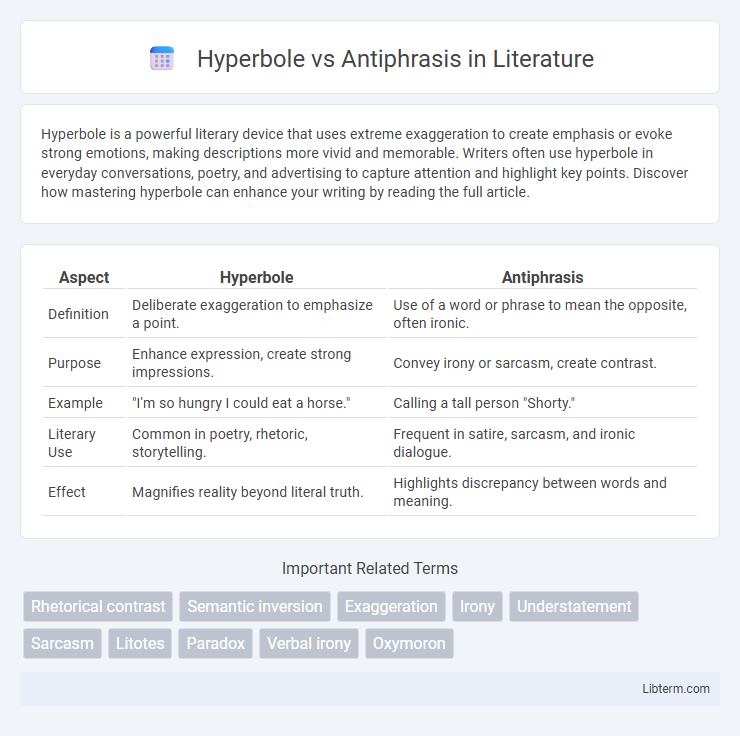Hyperbole is a powerful literary device that uses extreme exaggeration to create emphasis or evoke strong emotions, making descriptions more vivid and memorable. Writers often use hyperbole in everyday conversations, poetry, and advertising to capture attention and highlight key points. Discover how mastering hyperbole can enhance your writing by reading the full article.
Table of Comparison
| Aspect | Hyperbole | Antiphrasis |
|---|---|---|
| Definition | Deliberate exaggeration to emphasize a point. | Use of a word or phrase to mean the opposite, often ironic. |
| Purpose | Enhance expression, create strong impressions. | Convey irony or sarcasm, create contrast. |
| Example | "I'm so hungry I could eat a horse." | Calling a tall person "Shorty." |
| Literary Use | Common in poetry, rhetoric, storytelling. | Frequent in satire, sarcasm, and ironic dialogue. |
| Effect | Magnifies reality beyond literal truth. | Highlights discrepancy between words and meaning. |
Understanding Hyperbole: Definition and Purpose
Hyperbole is a figure of speech that involves deliberate exaggeration to emphasize a point or evoke strong emotions, often making descriptions more vivid and impactful. It serves the purpose of highlighting intensity or importance by stretching reality beyond literal truth, such as saying "I'm starving" to express extreme hunger. Understanding hyperbole allows effective use in literature, advertising, and everyday speech to create memorable and persuasive communication.
Antiphrasis Explained: Meaning and Usage
Antiphrasis is a rhetorical device where a word or phrase is used in a sense opposite to its literal meaning, often for ironic or sarcastic effect. Unlike hyperbole, which exaggerates for emphasis, antiphrasis conveys humor or criticism by stating the contrary of what is meant. Commonly found in literary works and everyday speech, antiphrasis enhances expressiveness by relying on context to reveal its true intent.
Key Differences Between Hyperbole and Antiphrasis
Hyperbole is a figure of speech that involves deliberate exaggeration to emphasize a point or evoke strong feelings, such as "I'm so hungry I could eat a horse," while antiphrasis uses words in a way that conveys the opposite of their literal meaning, often for ironic or humorous effect, like calling a tall person "Shorty." The key difference lies in hyperbole's intent to amplify reality, whereas antiphrasis intentionally reverses meaning to create contrast. Hyperbole enhances intensity and scale, whereas antiphrasis relies on contradiction and irony to convey its message.
Historical Origins of Hyperbole and Antiphrasis
Hyperbole originated in ancient Greek rhetoric as a deliberate exaggeration used by orators like Aristotle to emphasize a point and evoke strong emotional responses. Antiphrasis, rooted in classical literature and drama, emerged as a form of irony where a word or phrase is used in the opposite sense to create humor or sarcasm, tracing back to works by playwrights such as Aristophanes. Both figures of speech have historically evolved to enhance persuasive and expressive communication across diverse cultures and languages.
Common Examples of Hyperbole in Literature
Hyperbole, a deliberate exaggeration for emphasis or effect, appears commonly in literature as phrases like "I've told you a million times" or "He's as old as the hills," enhancing vivid imagery and emotional impact. In contrast, antiphrasis employs irony by using words in a sense opposite to their usual meaning, such as calling a giant "Tiny" to create humor or critique. Classic works like Shakespeare's Macbeth use hyperbole to intensify emotions, whereas antiphrasis often underlines satire or sarcasm.
Examples of Antiphrasis in Everyday Speech
Antiphrasis employs words in a sense opposite to their usual meaning, often sarcastically, such as calling a tall person "Shorty" or a slow-moving task "a breeze." In everyday speech, phrases like "Great job!" following a mistake or "Nice weather!" during a storm exemplify antiphrasis. These examples highlight how antiphrasis relies on context and tone to convey irony, contrasting with hyperbole's exaggerated expressions for emphasis.
Effects on Tone and Style: Hyperbole vs. Antiphrasis
Hyperbole amplifies language to create an exaggerated, often dramatic tone that emphasizes intensity or emotion, enhancing expressiveness and vividness in style. Antiphrasis employs irony by using words in the opposite sense to convey sarcasm or subtle humor, resulting in a tone that can be playful, ironic, or critical while adding nuance and complexity. The contrast lies in hyperbole's overt exaggeration versus antiphrasis's understated, often contradictory meaning, shaping distinct stylistic impacts on communication.
When to Use Hyperbole or Antiphrasis in Writing
Use hyperbole in writing to create emphasis or evoke strong emotions by exaggerating facts, such as "I'm so hungry I could eat a horse." Employ antiphrasis to convey irony or sarcasm by using words opposite to their literal meaning, like calling a clumsy person "Einstein." Choosing between hyperbole and antiphrasis depends on the writer's intent: hyperbole amplifies for dramatic effect, while antiphrasis subtly critiques or mocks through understatement or contradiction.
Misconceptions and Overlaps Between the Two Devices
Hyperbole and antiphrasis are often confused due to their use of apparent exaggeration, but they serve distinct rhetorical purposes; hyperbole amplifies reality to emphasize a point, while antiphrasis employs irony or sarcasm by stating the opposite of what is meant. Misconceptions arise when hyperbole's exaggeration is mistaken for antiphrasis' ironic intent, leading to overlapping interpretations in literature and everyday speech. Understanding the context and tone is key to correctly identifying hyperbole versus antiphrasis, as both devices exploit language ambiguity but achieve different effects.
Enhancing Writing with Figurative Language
Hyperbole enhances writing by using deliberate exaggeration to create strong emotional effects, making descriptions more vivid and impactful. Antiphrasis employs irony through a word or phrase that means the opposite of its literal sense, adding humor or emphasis and engaging readers with subtle contrasts. Both techniques enrich narrative tone and style by introducing figurative language that heightens reader interest and deepens meaning.
Hyperbole Infographic

 libterm.com
libterm.com